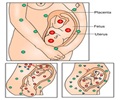A recent study has revealed the high risk of oral clefts among newborns of mothers who smoked during the first trimester of pregnancy.
The extensive Norwegian case-control study on oral clefts also revealed that the occurrence of cleft lip due to smoking has nothing to do with genes that play a role in detoxification of cigarette smoke.Oral clefts are one of the most common birth defects. Closure of the lip occurs about 5 weeks into pregnancy, followed by closure of the palate at week 9. If this does not happen, a cleft lip and/or cleft palate are the result, requiring surgery.
As part of the collaborative study, the researchers wanted to see if smoking or exposure to passive smoking play a role in these defects and whether genes influence the oral cleft risk through the way toxic chemicals in cigarette smoke are processed.
Between 1996 and 2001, 676 babies born with oral clefts were referred for cleft surgery, and of these, 573 took part in the study. 763 babies born during the same period in Norway were randomly selected as controls.
Blood samples were taken from the children referred for surgery and their PKU test samples, routinely taken at birth, were also retrieved. Their mothers and fathers donated cheek swabs and blood samples. From the control group, cheek swabs were obtained from the mother, father (after November 1998) and child, plus the PKU test sample taken at birth. DNA was extracted from the samples.
After four weeks of birth, the mothers in both groups completed a questionnaire about medical conditions and environmental exposure. They were specifically asked about their smoking habits and exposure to passive smoking before pregnancy and during the first trimester.
Advertisement
There was little evidence of an effect of smoking on the risk of cleft palate alone. However, there was a two-fold increased risk for cleft lip (with or without cleft palate), when the mother smoked over 10 cigarettes per day and a 1.6 fold risk from passive smoking (defined as being within 2 metres of a smoker for 2 hours a day).
Advertisement
Using the DNA extracted from the babies and their parents, the researchers looked at the genes related to detoxification of chemicals in cigarette smoke (NAT1, NAT2, CYP1A1, GSTP1, GSTT1, GSTM1).
However, these genes did not appear to affect the incidence of cleft lip, although there was an inconclusive link with NAT2 and cleft lip risk which was independent of smoking.
The mechanism by which maternal smoking increases the risk of cleft lip remains unknown.
The study is published in the journal Epidemiology.
Source-ANI
SAV















